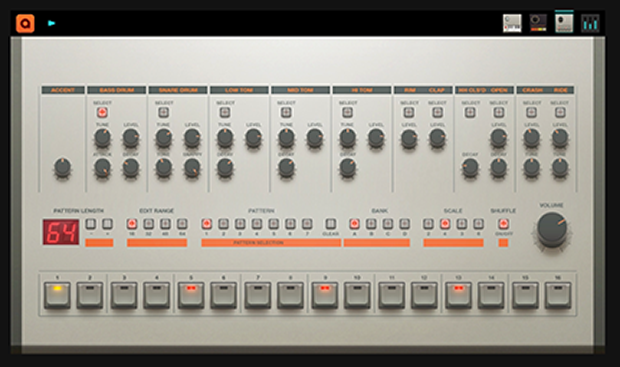Google Chrome Drum Machines on Audiotool’s Sketch

By Ruben Lone
Cologne, Germany-based Audiotool has created a browser-based music production suite that fuses the immediacy of modular synthesis with the accessibility of the internet. Audiotool offers a free workstation for producers interested in electronic music synthesis, with proprietary instruments, effects, and mixing controls all in a broswer window. Audiotool’s site also functions as a community for producers and composers who have cerated music using the platform, and Audiotool provides in-depth reference Wikis for each of its devices.
As part of Google’s Chrome Experiments, which showcase creative web coding applications built in HTML5 and Java, Audiotool has designed a standalone sequencer app called Sketch. Sketch is modeled on of iconic analog drum machines and bassline synthesizers, which three web-based versions of the Roland TR-808, TR-909, and TB-303. These instruments, widely used in house and techno styles, are an entry point (if not a mainstay) for electronic music production, as the basis of their functionality is essential to most of the sequencer instruments that succeeded them.
The Sketch experiment is quite easy to use if you have a general understanding of digital audio workstations or basic audio signal routing. The browser panels include a mixer with panning, delay, and level controls. The delay effects can be adjusted based on 16-note subdivisions with control knobs for feedback and level. Each channel has options for choosing patterns from each of the devices for quick arrangement edits. There is also a BPM adjust and “groove” knob that adjusts the swing factor of the rhythms across each device.
The “Bassline” is modeled on the TB-303 with a very similar interface to the analog machine. When programming a bassline, it isn’t possible to preview the note, but the accent, slide, transposition, and step index buttons are very clearly displayed and straightforward to use. The waveform controls at the top are the basic 303 options–waveform, tuning, filter cutoff frequency, filter resonance, envelope mode, decay, and accent level.
The Beatbox 8 and Beatbox 9, modeled after the 808 and 909 respectively, are equally functional, if not easier to use than the Bassline device. The step sequencers can be arranged in up to 4 16-bar patterns, with options for various classic Roland drum sounds.
Audiotool built Sketch using a proprietary platform called defrac, which allows multiple devices to be programmed with a single code. The only setback of Sketch is intrinsic to its browser functionality, in that clicking in sequences takes much longer than pushing the buttons of an analog devices with your hands. However, if the Chrome experiment becomes available on the iPad or another tablet device, it could certainly open doors to an interesting opportunity for internet-based, improvisatory electronic music creation.









